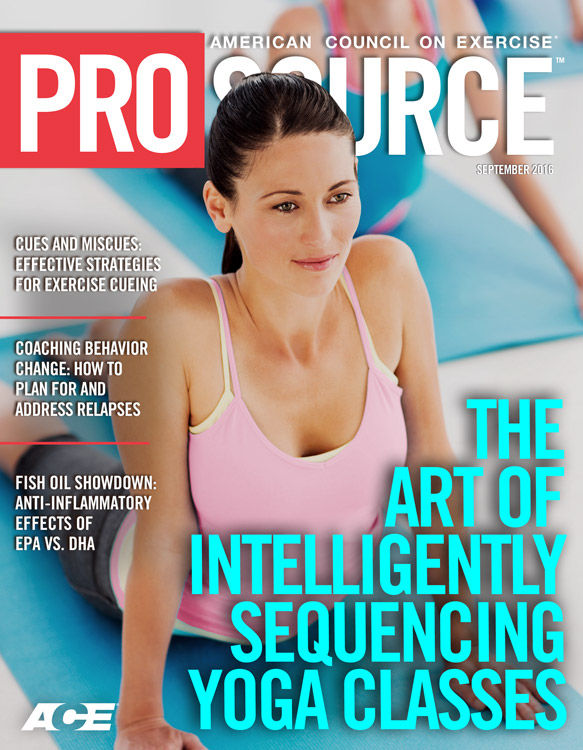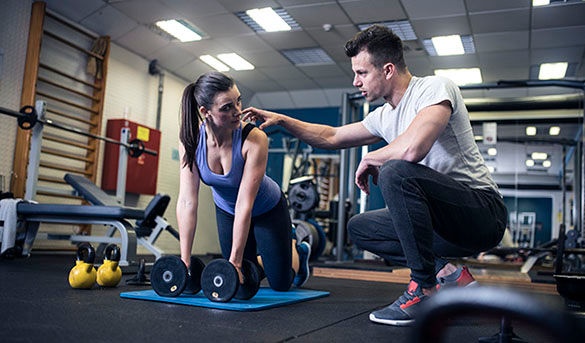
Your primary role as a group fitness instructor or personal trainer is to provide clear, concise instructions and feedback to guide clients to safely execute the exercises you’ve programmed for a specific workout. Effective communication and the ability to coach others to perform movements safely are essential to your—and your client’s—success. While effective techniques for coaching and cuing exercise can be acquired through on-the-job trial-and-error or by taking the time to study seasoned professionals, research suggests that some approaches may be more effective than others.
Internal vs. External Focus
Recent studies have looked specifically at something called “focus of attention” (FOA) and have concluded that the learning and execution of bodily movements can be enhanced by the way in which verbal instructions and feedback are delivered (Benz et al.,2016; Winkelman, 2015).
Specifically, providing coaching instructions or movement cues that focus on the specific outcome of a movement can be more effective and lead to a better learning experience when compared to guiding participants to focus on specific muscles or joints involved in a movement.
Researchers have identified two types of attentional focus: internal and external. Internal focus describes the act of paying specific attention to the action of the body involved in the movement. External focus, by contrast, coaches the participant to pay attention to the effect or outcome of a movement on its surrounding environment (or the implement involved in the action). The constrained action hypothesis (CAH) is the belief that a specific FOA can help individuals learn how to execute and repeatedly perform new movement patterns. The CAH states that the quality of a movement depends, in large part, on an individual’s FOA when learning the new skill, and that directing a learner’s attention externally allows his or her motor-control system to operate under automatic processes, which means that movement occurs reflexively, resulting in the desired outcomes (Kal, van der Kamp and Houdijk, 2013; Lohse, Sherwood and Healy, 2013; Wulf, 2007; Wulf et al., 2002).
If you’ve ever had a coach or instructor tell you that you’re “overthinking” a movement, he or she may have been right. According to research by Wulf, McNevin and Shea (2001), thinking about the process of a movement by focusing on the internal actions of the body “constrains the motor system by interfering with automatic motor control processes that would normally regulate the movement.” On the other hand, an external focus can reduce interference from conscious thought, allowing reflexive control to guide movements naturally and organically.
Cues that emphasize an internal FOA can create a distraction, which restricts the learning process as the participant consciously thinks about the separate components of an action (Table 1). An external FOA, however, instructs a learner to pay attention to the outcome of a movement, which can help various muscles and body segments to work in synergy to produce the desired effect. When coaching participants to focus on a particular muscle or joint motion, group fitness instructors or personal trainers are actually using an internal FOA. However, a growing body of research demonstrates that coaching movement with an external FOA can be a more effective strategy for helping clients and class participants learn more quickly and better retain the information when being introduced to a particular movement or skill (Benz et al., 2016; Kal, van der Kamp and Houdijk, 2013; Lohse, Sherwood and Healy, 2013; Wulf, 2007; Wulf et al., 2002).

“When concentrating on the movements themselves, performers appear to actively intervene in the control processes, resulting in degraded performance and learning,” writes Wulf and associates (2002). An external FOA directs clients or group fitness class participants to change the focus from the process of the movement to the desired outcome. The research demonstrates that focusing on the specific outcome of a movement can be more important than directing a learner’s attention to the mechanical components of the movement. Findings suggest that clients and participants do not necessarily need direct references to bodily movements to learn the appropriate form for a particular exercise. An external FOA can lead to a more effective execution of a particular movement during both the learning and retention phases of motor skill development (Table 2). Furthermore, participants who received feedback that referred to the outcomes of a movement were more successful at learning and retaining that skill than when guided to focusing on the muscle and joint actions required to perform a particular pattern (Benz et al., 2016; Kal, van der Kamp and Houdijk, 2013; Lohse, Sherwood and Healy, 2013; Wulf, 2007; Wulf et al., 2002).
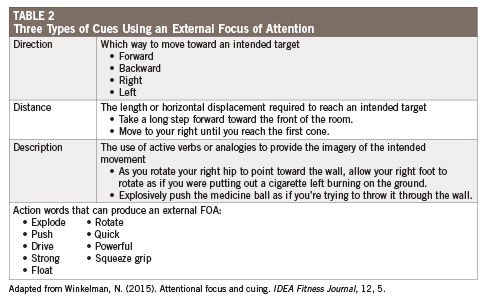
Hannah Sansome, a group fitness instructor at Equinox in Carlsbad, Calif., has found that using an external FOA is extremely valuable when leading group workouts. “I think the most effective cuing combines directional and visual cues, with kinesthetic cues provided while the exercise is being performed. It’s important to take into account that every class will have a mix of visual learners who mimic your movements, auditory learners who are capable of converting your instructions into movements, and tactile learners who understand how to activate specific muscles and joints to create movements,” Sansome explains. “If you can effectively direct the class in what to do and where to move, while also providing a visual representation of that movement, participants can quickly process the information and understand how they should perform the movement.”
Angela Leigh, a Los Angeles-based yoga instructor for Equinox agrees. “I use simple, target-based cues that I know to be relevant to the individuals in each class,” she says.
One possible reason why using an internal FOA may slow learning is that many clients and class participants are unfamiliar with anatomical terms (which health and fitness professionals tend to use), so instead of focusing on the outcome of a particular movement the learners are trying to remember which body part they are supposed to be moving in the first place. Using an external FOA by providing directional cues, such as moving a body part toward a specific area like a wall, ceiling or floor, can give more relevant information a learner can easily understand and apply. An external FOA can result in higher learning rates when compared with internal focus instructions; cues that use active verbs, analogies and/or words that evoke images can be significantly more memorable and easier for clients to apply (Table 3).
“Focusing on the implement being moved, rather than the process underpinning that movement, frees the motor system to organize in a way that maximizes efficiency (muscle recruitment) and performance (movement velocity),” argues Winkelman (2015). “Conversely, focusing on the ‘muscles’ involved in the desired movement forces the motor system to explicitly manage local muscle performance rather than global inter- and intramuscular coordination.”
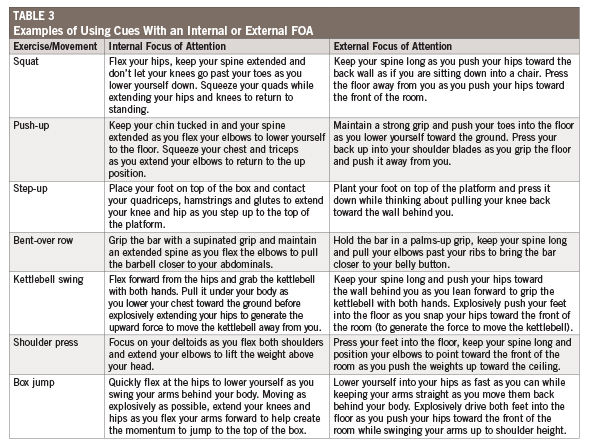
How to Identify the Most Effective Cueing Methods for Your Clients
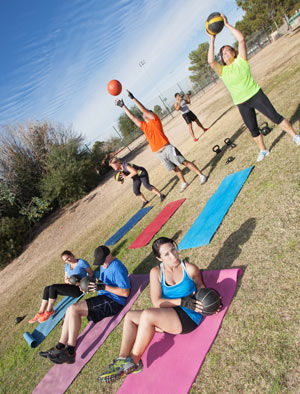
These findings do not mean that you should never use an internal FOA; however, it is important to understand the difference between the two styles to help you identify the most effective cuing and coaching methods for your needs. Teaching clients about which muscles or joints are involved in an exercise can help them learn more about their anatomy, but when it comes to teaching a new or complicated movement pattern, using an external FOA can help speed up the learning process.
Kira Stokes, a New York City-based personal trainer whose STOKED series of group classes attract the city’s top instructors and trainers, incorporates cues for both an internal and external FOA for her workouts. “When I teach, I provide specific cues to help my participants learn about their bodies. I encourage them to feel their feet, knees, hips, back, shoulders and head, and coach them on where they should be feeling each exercise” she explains.
For instructors or trainers who teach circuit-based group workouts, it is imperative to provide clear directions and instructions so that participants know what is expected of them during each exercise. Clear instructions are especially necessary where exercises are demonstrated and clients are expected to be able to execute at their own pace. A benefit of circuit-style class formats is that it is easier for new instructors to learn how to teach to a group when compared to choreographed dance classes. However, it is still necessary for instructors to practice communicating effectively to deliver instructions for the workout.
“When first teaching, many instructors have a habit of talking too much because they are nervous,” says Doris Thews, an ACE Certified Group Fitness Instructor and a Master Trainer for Schwinn Cycling. “Don’t let your nerves take over and rush through your instructions. Pay attention and edit your words in an attempt to use the least amount of words to get the biggest ‘bang for your buck’ from the participants. Speak slowly and allow time for them to process the information.”
For newer instructors, Sansome offers the following recommendations. “First, keeping instructions simple, concise and absolutely relevant helps take your teaching to the next level. Secondly, I believe in eye contact. As instructors, we aren’t there to watch ourselves in the mirror, and it’s not our workout—it belongs to the members. In addition, looking a participant in the eye and offering a smile helps them feel noticed and included, and in return what you often receive is their attention.”
Of course, not all people will respond to your coaching cues the same way, so take the time to experiment with the cues that work best for your audience. Have fun, use different images or directional cues and keep track of how easy they are to interpret. Ask some of your regulars, “Did that make sense to you?” Ask a newbie, “Were you able to understand the intention of the directions?” Providing too much information about how to perform an exercise can slow down client comprehension and actually impede the ability to learn and execute a movement pattern.
Importantly, movement has to be contextual and provide a specific relevance between a skill a client is familiar with and the new skill he or she is attempting to acquire (Winkelman, 2015). If one or two clients or group fitness participants have a difficult time performing an exercise following your verbal directions, it could be that they did not interpret the cues correctly. However, if a number of people don’t perform the proper movements or don’t seem to understand what they are supposed to do, it is probably time to identify a more effective method of communicating the instructions.
“It doesn’t matter how many times my athletes (I refer to all of my group fitness participants as ‘athletes’) or clients have performed a squat, lunge, push-up or plank, I always demonstrate and cue as if they have never done one in their life,” explains Stokes. “A trainer or instructor should never become lazy and take the ‘you’ve all been here before so you’re making my job easy today’ approach and slack on providing proper information and insight for every movement.”
In addition to practicing your cuing, Stokes recommends watching people’s faces and “reading the room” to know that your instructions are being properly received. “I watch body language and facial expressions to help choose the cues I give to help encourage each and every athlete perform at their best,” she says.
Turning Weaknesses Into Strengths

Taking the time to record and objectively review a performance can help instructors identify weaknesses that can be turned into future strengths. Sansome recommends that newer instructors take advantage of technology and use a phone or tablet to record themselves teaching.
“It’s the rare instructor who enjoys watching themselves teach a group exercise class, but it’s a terrific way to recognize and address any flaws in our communication,” Sansome argues. “Once you record yourself, try to objectively address your performance as an instructor. Are you concise or are you chatty? Do you smile and project positive confidence, or do you seem unsure and nervous? Do you constructively command the room, or do you stumble through, with inattentive members and a lack of group energy? And most important, when you demonstrate exercises, do participants easily catch on, or is your cuing potentially halting the success of your class?”
To identify the best method of attentional focus to meet your needs, perform this simple exercise: Over the next few days, challenge yourself to deliver cues using both an internal and external FOA to identify which method your clients and class participants have an easier time following. Understanding the difference between using cues that have an internal or an external FOA can improve your coaching skills, which will result in more people walking away from your workouts feeling successful, thus improving the number of people you’re able to help.
References
Benz, A. et al. (2016). Cues for enhancing sprint performance. Strength & Conditioning Journal, 38, 1, 1-11.
Kal, E.C., van der Kamp, J. and Houdijk, H. (2013). External attentional focus enhances movement automatization: A comprehensive test of the constrained action hypothesis. Human Movement Science, 32, 527-539.
Lohse, K., Sherwood, D. and Healy, A. (2013). On the advantage of an external focus of attention: A benefit to learning or performance. Human Movement Science, 32, 1-15
Winkelman, N. (2015). Attentional focus and cuing. IDEA Fitness Journal, 12, 5.
Wulf, G. (2007). Attentional focus and motor learning: A review of 10 years of research. Bewegung und Training, 1-11.
Wulf, G. et al. (2002). Enhancing the learning of sport skills through external-focus feedback. Journal of Motor Behavior, 34, 2, 171-182.
Wulf, G., McNevin, N and Shea, C.H. (2001). The automaticity of complex motor skill learning as a function of attentional focus. Quarterly Journal of Experimental Psychologically, 54, 4, 1143-1154.





 by
by 